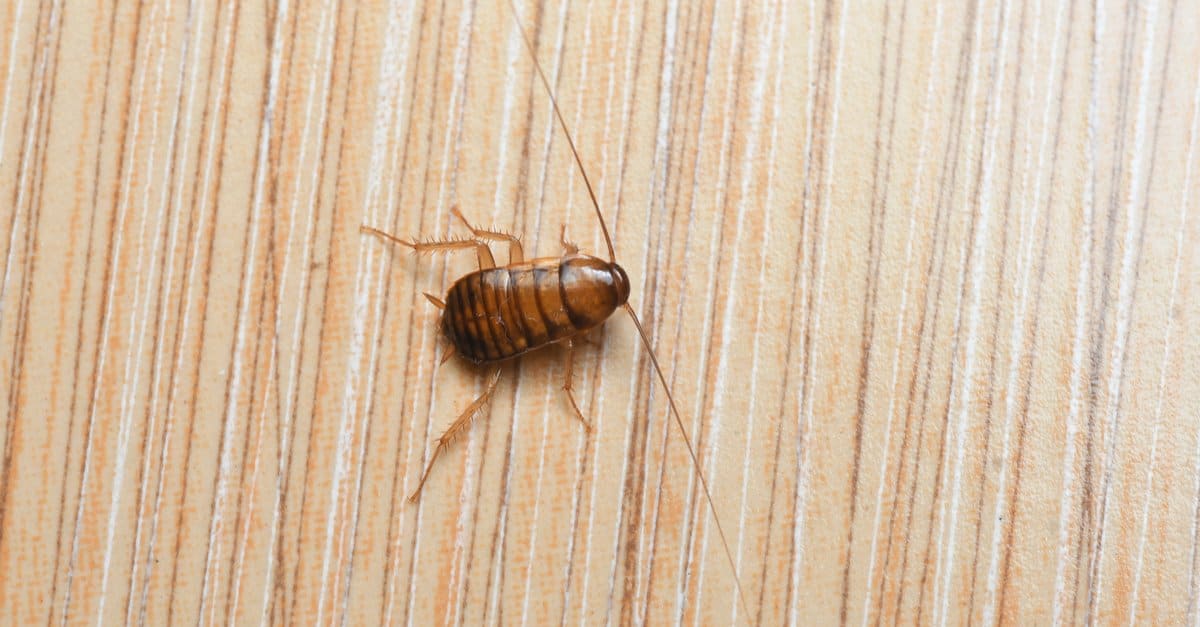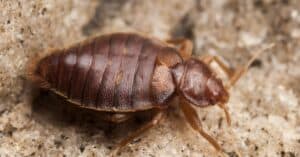Bed bugs are unwelcome houseguests that no one wants to deal with. These tiny, blood-sucking pests can turn a peaceful night’s sleep into a nightmare, leaving itchy, red bites in their wake. Desperate to rid their homes of these persistent creatures, many people turn to home remedies, and one of the most commonly suggested solutions is baking soda. But does baking soda kill bed bugs, or is it just another internet myth?
Explore the potential effectiveness of using baking soda as a bed bug remedy and discover essential information to consider before attempting to tackle an infestation with this household staple. Before you dust your mattress and linens with baking soda, let’s dive into the facts and separate fiction from reality when it comes to using baking soda as a bed bug control method.
What Are Bed Bugs?
Bed bugs, scientifically known as Cimex lectularius, are small, wingless insects that belong to the family Cimicidae. These nocturnal pests are well-known for their blood-feeding habits, primarily targeting humans and warm-blooded animals.
Bed bugs are typically reddish-brown to mahogany in color. They have flat, oval-shaped bodies, which can appear swollen and elongated after feeding. Additionally, adult bed bugs are about the size of an apple seed, typically measuring 4 to 5 millimeters in length.
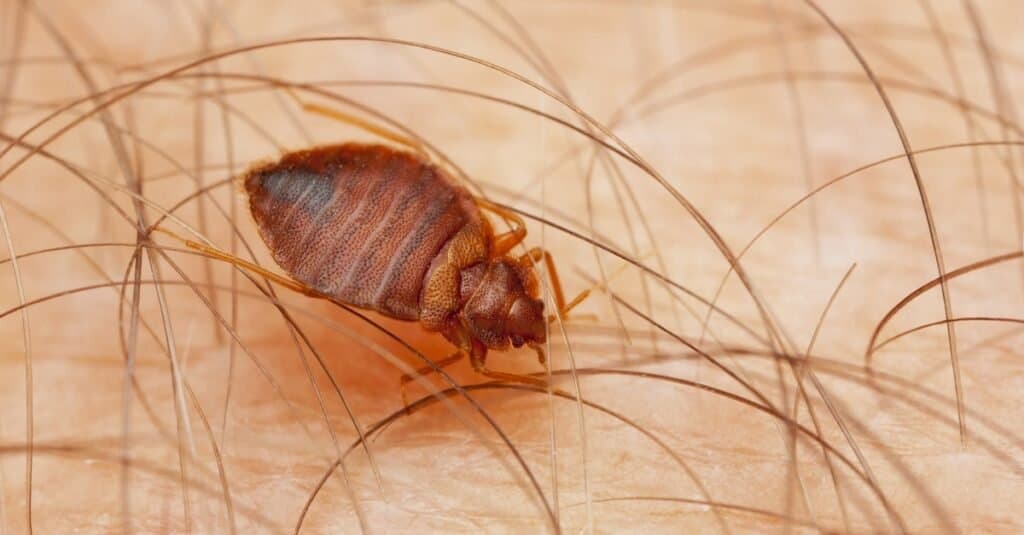
Bed bugs develop a remarkable resistance to various substances, including pesticides.
©Pavel Krasensky/Shutterstock.com
Behavior
Understanding the characteristics of bed bugs is essential for effective identification and control.
- Nocturnal feeding: Bed bugs are primarily active at night, seeking out their hosts while they sleep. They are attracted to the warmth and carbon dioxide emitted by humans.
- Hiding and nesting: During the day, bed bugs hide in cracks, crevices, and other concealed locations close to their feeding source, such as mattresses, box springs, bed frames, and upholstered furniture.
- Reproduction: Bed bugs reproduce rapidly. A single female bed bug can lay hundreds of eggs in her lifetime. These eggs hatch into nymphs, which undergo several molts before becoming adults.
- Feeding habits: Bed bugs use their specialized mouthparts to pierce the skin and feed on blood. They typically feed for five to ten minutes before retreating to their hiding spots.
Does Baking Soda Kill Bed Bugs?
Baking soda, also known as sodium bicarbonate, is a versatile household product often lauded for its cleaning and deodorizing properties. It is no surprise that some people have turned to baking soda as a potential solution for dealing with bed bug infestations. However, the effectiveness of baking soda in killing bed bugs is a matter of debate.
The Rationale Behind Using Baking Soda
The idea behind using baking soda against bed bugs is that it might desiccate or dry out pests due to its abrasive nature. Advocates of this method suggest that when bed bugs come into contact with baking soda, it could damage their exoskeletons and lead to dehydration, ultimately causing their demise.
Research and Evidence
While the concept of baking soda causing physical harm to bed bugs makes sense in theory, there is a notable lack of scientific evidence to support its effectiveness as a standalone bed bug killer. Research on this specific topic is limited, and the results have been inconclusive at best.
Ultimately, it is crucial to weigh the pros and cons of using baking soda. While it may have some limited impact on bed bugs, it is unlikely to be a silver bullet for a full-scale infestation. Rather than relying solely on baking soda, consider a multifaceted approach that includes professional pest control services, proper cleaning, and preventive measures.
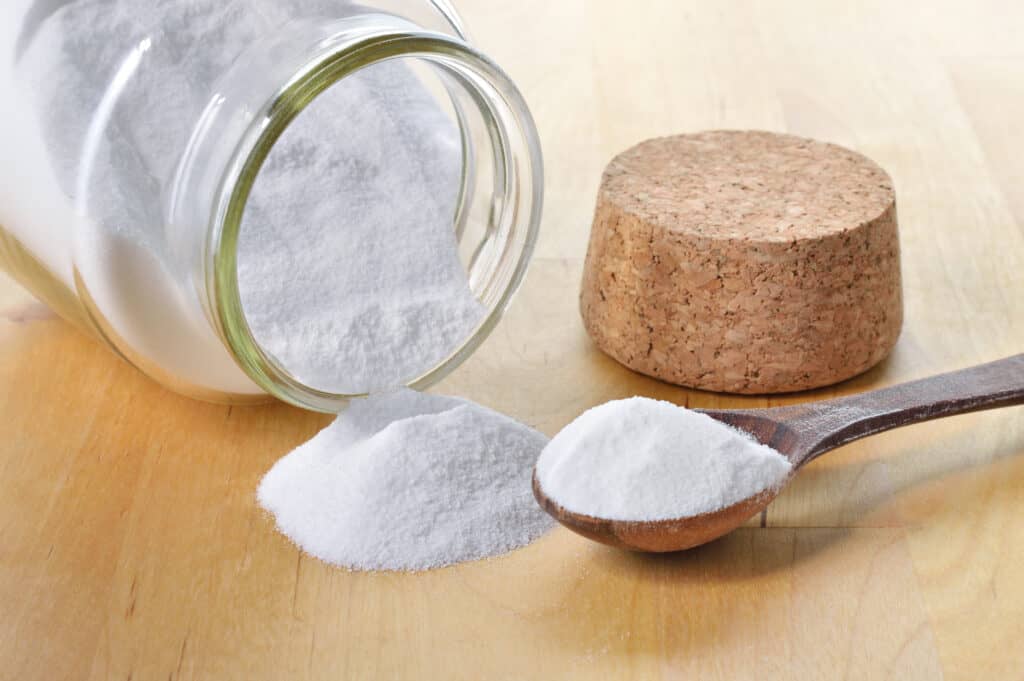
Does baking soda kill bed bugs? Baking soda is believed to work against bed bugs by acting as a desiccant, absorbing moisture and drying out their exoskeletons.
©Geo-grafika/Shutterstock.com
9 Important Things to Know Before Using Baking Soda to Kill Bed Bugs
If you are considering using baking soda as a remedy for a bed bug infestation, there are several crucial factors to keep in mind before diving into this method. While baking soda is readily available and affordable, its effectiveness and safety may not always align with expectations. Here are some essential considerations:
1. Limited Scientific Evidence
As mentioned earlier, scientific studies on the effectiveness of baking soda against bed bugs are scarce. The lack of concrete evidence makes it challenging to rely solely on baking soda for bed bug control.
2. Not a Standalone Solution
Baking soda should not be viewed as a standalone solution for bed bug infestations. These pests are notoriously resilient, and an integrated approach involving various methods is typically required for effective control.
3. Potential Delays
Relying solely on baking soda may lead to delays in addressing the infestation. Bed bugs can reproduce rapidly, so any delay in effective control measures can result in the problem worsening.
4. Resistance Concerns
Bed bugs have developed resistance to many substances over time, including some pesticides. It’s unclear whether they can adapt to baking soda, but resistance is a concern that should not be underestimated.
5. Safety Precautions
When using baking soda, it is essential to take safety precautions. Avoid excessive inhalation of baking soda dust, as it can irritate the respiratory system. Additionally, ensure that it does not come into contact with eyes, and keep it out of reach of children and pets.
6. Comprehensive Approach
Bed bug control is most effective when approached comprehensively. Consider combining baking soda with other proven methods such as professional pest control services, heat treatments, and thorough cleaning.
7. Professional Assessment
If you suspect a bed bug infestation, it is wise to seek the expertise of a professional pest control service. They can accurately identify the extent of the infestation and recommend appropriate treatments.
8. Regular Inspection and Preventive Measures
Even after addressing a bed bug infestation, it is crucial to maintain vigilance. Regularly inspect your living spaces and take preventive measures, such as using bed bug-proof encasements and practicing good hygiene.
9. Patience and Persistence
Bed bug elimination can be a challenging and time-consuming process. Be prepared for the possibility that multiple treatments may be necessary to completely eradicate these pests.
While baking soda may have some potential as a supplementary measure in bed bug control, it should not be your sole reliance. Understanding its limitations, safety precautions, and the need for a comprehensive approach is essential. To effectively combat bed bug infestations, consult with professionals and consider a combination of proven methods to ensure long-lasting relief from these persistent pests.
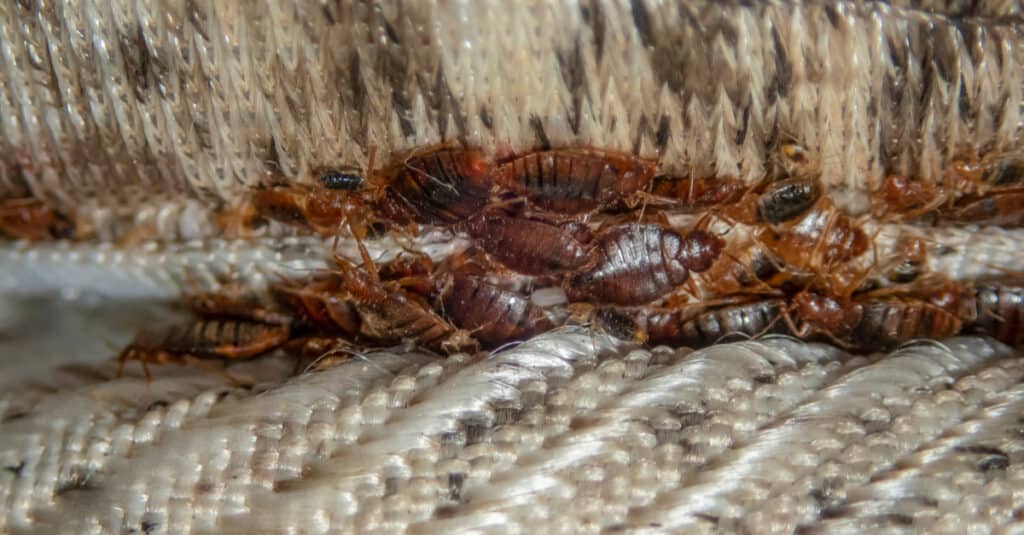
Bed bugs are not a recent problem. In fact, they have been bothering humans for thousands of years.
©Dmitry Bezrukov/Shutterstock.com
How to Use Baking Soda to Kill Bed Bugs
If you are determined to try using baking soda as part of your bed bug control efforts, here is a step-by-step guide on how to use it. Keep in mind that while this method may have limited effectiveness, it should be part of a more comprehensive approach to dealing with bed bugs.
Materials You’ll Need:
- Baking soda (sodium bicarbonate)
- A handheld or kitchen sieve
- A brush or broom
- Vacuum cleaner with a hose attachment
- Bed bug-proof mattress and pillow encasements
Steps:
- Preparation: Remove bedding, linens, and anything that might be harboring bed bugs. Wash and dry these items on the hottest settings your fabrics can tolerate.
- Vacuuming: Vacuum the affected areas, such as your mattress, box spring, bed frame, and surrounding areas. Pay close attention to seams, crevices, and cracks where bed bugs may hide.
- Sieving baking soda: Pour a moderate amount of baking soda into your sieve. This will help you distribute the baking soda evenly.
- Application: Sprinkle the baking soda over the areas you have vacuumed. Be sure to cover all potential hiding spots, including the mattress, box spring, cracks in the bed frame, and any nearby furniture.
- Brushing and settling: Use a brush or broom to gently spread the baking soda evenly across the surfaces.
- Let It sit: Allow the baking soda to sit undisturbed for a few hours, preferably overnight. Bed bugs will theoretically come into contact with it as they move around.
- Vacuum again: After the waiting period, vacuum the treated areas using a hose attachment to access crevices and corners. Dispose of the vacuum bag or empty the canister immediately in an outdoor trash container.
- Encasements: To prevent reinfestation, consider using bed bug-proof encasements for your mattress and pillows. These encasements create a barrier that prevents bed bugs from accessing or escaping the mattress and pillows.
- Repeat as necessary: Keep in mind that this process may need to be repeated multiple times. Monitor the situation, and if the problem persists, consider consulting with a professional pest control service.
Remember that while baking soda may have some limited impact on bed bugs, it is not a guaranteed solution, especially for severe infestations. Combining this method with other proven bed bug control strategies is advisable for effective eradication.
How Long Does Baking Soda Take to Work Against Bed Bugs?
The effectiveness and timeline for baking soda to work against bed bugs can vary widely depending on several factors, including the extent of the infestation, the specific conditions in your home, and the treatment method used. Baking soda is not a rapid bed bug killer, and its impact may be limited. Here’s what you need to know about the time it takes for baking soda to potentially affect bed bugs.
Gradual impact
Baking soda is not a chemical pesticide that acts quickly to kill bed bugs on contact. Instead, it desiccates or dries out the pests. This also means that it may take a while for its effects to become noticeable.
Varied Results
The time it takes for baking soda to affect bed bugs can vary from several days to weeks or more. Additionally, some bed bugs may come into contact with the baking soda and experience desiccation sooner, while others may take longer.
Infestation Size
The size of your bed bug infestation plays a significant role in the timeline. Smaller infestations may show signs of improvement more quickly, while larger infestations can be more resilient and may require extended treatment periods.
Treatment Method
The effectiveness of baking soda can also depend on how it is applied. Evenly distributing and properly applying baking soda to bed bug hiding spots is essential for it to have any impact. Brushing it into cracks and crevices where bed bugs hide can improve its effectiveness.
Reinfestation
Bed bugs reproduce rapidly, and even if baking soda appears to have an impact on the existing population, reinfestation can occur if eggs and hidden bed bugs are not adequately addressed.
Comprehensive Approach
Using baking soda alone is unlikely to eliminate a bed bug infestation completely. A comprehensive approach that includes professional pest control services, heat treatments, and thorough cleaning is often necessary for long-term eradication.
Baking soda’s timeline for noticeable results can vary widely and may not provide the level of control needed for a significant infestation. If you suspect a bed bug problem, it is advisable to consult with professional pest control experts who can assess the situation and recommend appropriate treatments to address your infestation effectively.

Bed bugs are incredibly stealthy when they feed on their hosts. They inject a tiny amount of anesthetic into their victims before feeding, which numbs the area and often prevents people from feeling the bites until later.
©OttoPles/Shutterstock.com
What Are the Signs of a Bed Bug Infestation?
Bed bugs are elusive, but several signs can indicate a bed bug infestation. Being vigilant and recognizing these signs can help you take action. Here are the common signs of an infestation:
- Bites on the skin: Bed bug bites appear as small, itchy, red welts on exposed areas of the body, such as the face, neck, arms, and hands. Additionally, they often occur in a linear or clustered pattern.
- Blood stains on bedding: Bed bugs feed by piercing the skin and consuming blood. If you or someone in your household is being bitten, you may notice small bloodstains on the sheets, pillowcases, or mattress cover.
- Dark fecal spots: Bed bugs excrete digested blood as dark, rusty-colored fecal spots. These spots may be found on bedding, mattress seams, or nearby furniture. They can also appear like small, ink-like dots.
- Cast skins: Bed bugs shed their exoskeletons as they grow, leaving behind translucent shells or casings. These cast skins can accumulate in areas where bed bugs hide, such as mattress seams, cracks, and crevices.
- Unpleasant odor: Some people describe the scent of a severe bed bug infestation as musty or sweet. This odor is often more noticeable in heavily infested areas.
- Visible bed bugs: In advanced infestations, you may see adult bed bugs. They are about the size of an apple seed, reddish-brown when unfed, and become darker and more elongated after feeding.
- Eggs: Bed bug eggs are tiny, white, and about the size of a pinhead. They may be found in clusters, usually in the same areas where bed bugs hide.
- Bite reactions: Some people may have allergic reactions to bed bug bites, leading to more pronounced symptoms like severe itching, swelling, or blistering. Additionally, some individuals report a sensation of something crawling on their skin when bed bugs are present.
Pro Tip
Inspect common hiding spots for bed bugs, such as seams, folds, and crevices of mattresses, box springs, bed frames, upholstered furniture, and baseboards. Use a flashlight to check these areas thoroughly.
It is important to note that bed bugs are skilled at hiding, and infestations can go unnoticed for some time. Regularly inspecting your sleeping and sitting areas, especially after travel or when acquiring used furniture, can help you detect an infestation early. If you suspect a bed bug infestation, seek professional pest control assistance for proper identification and effective treatment.
A Realistic Perspective on Baking Soda and Bed Bug Control
In the quest to rid your home of bed bugs, the allure of a readily available and seemingly harmless solution like baking soda may be tempting. However, it is crucial to approach this method with a realistic understanding of its limitations and effectiveness.
Baking soda, while a versatile household product, is not a magic bullet for bed bug control. Its potential to desiccate bed bugs, leading to their eventual demise, is a concept with limited scientific backing. The timeline for baking soda to work against bed bugs can vary widely, and its impact may be insufficient for a severe infestation.
Furthermore, bed bugs are notorious for their resilience and adaptability. Early detection through careful monitoring and regular inspections is the key to preventing infestations from escalating. If you suspect a bed bug problem, don’t hesitate to seek the guidance of pest control experts who can accurately assess your situation and recommend appropriate treatments.
Thank you for reading! Have some feedback for us? Contact the AZ Animals editorial team.

